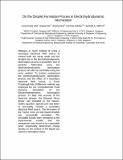| dc.contributor.author | Lim, Liang Kuang | |
| dc.contributor.author | Xie, Jingwei | |
| dc.contributor.author | Hua, Jinsong | |
| dc.contributor.author | Wang, Chi-Hwa | |
| dc.contributor.author | Smith, Kenneth A. | |
| dc.date.accessioned | 2007-02-06T12:00:00Z | en_US |
| dc.date.available | 2007-02-06T12:00:00Z | en_US |
| dc.date.issued | 2007-01 | |
| dc.identifier.uri | http://hdl.handle.net/1721.1/35875 | |
| dc.description.abstract | A novel method of using a secondary electrical field source to control both the spray mode and the droplet size in the electrohydrodynamic atomization process is presented. Size of particles fabricated using the electrohydrodynamic atomization
process can also be controlled using the
same method. To further understand the electrohydrodynamic atomization process and the effect of a secondary electrical field source, a Front Tracking/Finite Difference method was employed for the Computational Fluid Dynamic Simulation of the
Electrohydrodynamic Atomization process. To take into account of the electrical stresses, the Maxwell Stress tensor was included in the Navier-Stokes equation. Special care was taken
to accurately include a secondary electrical field source. The formation of the Taylor Cone, jet and liquid droplets was successfully simulated. The simulated results were compared to the experimental results and the
comparison was found to be reasonable when empirically determined charge density on the surface of the liquid was used as a simulation input. | en |
| dc.description.sponsorship | Singapore-MIT Alliance (SMA) | en |
| dc.language.iso | en | en |
| dc.relation.ispartofseries | Chemical and Pharmaceutical Engineering (CPE) | en |
| dc.subject | Electrohydrodynamic | en |
| dc.subject | Computational Fluid Dynamics | en |
| dc.subject | Droplets Formation | en |
| dc.subject | Electrical Field | en |
| dc.title | On the Droplet Formation Process in Electrohydrodynamic Atomization | en |
| dc.type | Article | en |
